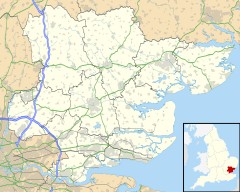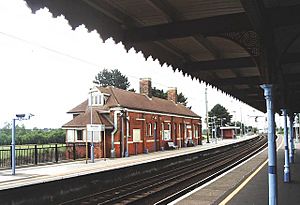Manningtree facts for kids
Quick facts for kids Manningtree |
|
|---|---|
 The River Stour at Manningtree |
|
| Population | 911 (2011 census) |
| OS grid reference | TM105317 |
| District |
|
| Shire county | |
| Region | |
| Country | England |
| Sovereign state | United Kingdom |
| Post town | MANNINGTREE |
| Postcode district | CO11 |
| Dialling code | 01206 |
| Police | Essex |
| Fire | Essex |
| Ambulance | East of England |
| EU Parliament | East of England |
| UK Parliament |
|
Manningtree is a town and civil parish in the Tendring district of Essex, England, which lies on the River Stour. It is part of the Suffolk Coast and Heaths Area of Outstanding Natural Beauty.
Contents
Smallest town claim
Manningtree has traditionally claimed to be the smallest town in England, but its 2007 population of 700 people in 20 hectares and the 2011 census population for the civil parish of 900 are much higher than the 351 population of Fordwich, Kent. However, it is believed to be the smallest town by area.
In April 2009 it was proposed that Manningtree should merge with Mistley and Lawford to form a single parish, losing its separate identity as a town. As of 2023 such a merger has not occurred.
History
The name Manningtree is thought to derive from 'many trees'. The town grew around the wool trade from the 15th century until its decline in the 18th century and also had a thriving shipping trade in corn, timber and coal until this declined with the coming of the railway. Manningtree is known as the centre of the activities of Matthew Hopkins, the self-appointed Witchfinder General, who claimed to have overheard local women discussing their meetings with the devil in 1644 with his accusations leading to their execution as witches.
Many of the buildings in the centre of the town have Georgian facades which obscure their earlier origins. Notable buildings include Manningtree Library, which was originally built as 'a public hall for the purposes of corn exchange' and was later used around 1900 for public entertainment, and the Methodist church located on South Street, completed in 1807.
The Ascension, by John Constable, which now hangs in Dedham church, was commissioned in 1821 for the altarpiece of the early seventeenth-century church on the High Street, demolished in 1967.
Governance
Manningtree is part of the electoral ward called Manningtree, Mistley, Little Bentley and Tendring. The population of this ward at the 2011 census was 4,603.
Geography
Manningtree is on Holbrook Bay, part of the River Stour in the north of Essex. It is the eastern edge of Dedham Vale.
Nearby villages include Dedham, Mistley, Lawford, Wrabness and Brantham.
Transport
Manningtree railway station is on the Great Eastern Main Line and provides regular, direct services to London, Norwich and Harwich.
Media
Local news and television programmes are provided by BBC East and ITV Anglia. Television signals are received from the Sudbury TV transmitter.
The town is served by both BBC Essex and BBC Radio Suffolk. Other radio stations including Heart East, Greatest Hits Radio Essex, and Actual Radio.
Harwich and Manningtree Standard is the town's local newspaper which publishes on Fridays.
In fiction
Manningtree features in Ronald Bassett's 1966 novel Witchfinder General and in A. K. Blakemore's 2021 novel The Manningtree Witches.
In Shakespeare’s Henry IV Part I (Act 2 Scene 4), Flastaff is referred to as “that roasted Manningtree ox“. This was marked in 2000 with a sculpture of an ox in the town centre.
A. K. Blakemore's 2021 novel, The Manningtree Witches, is set in the town. The novel won the Desmond Elliott Prize 2021, being described by the judges as "a stunning achievement."
Notable people
- Margaret Thatcher lived and worked in Manningtree and worked for BX Plastics
- Matthew Hopkins, the self-styled Witch-Finder General, lived in Manningtree
- Henry Patten, the 2024 Gentlemen's Wimbledon doubles champion lived in Manningtree.
Twin town
Manningtree is twinned with Frankenberg, Hesse, Germany.
See also
 In Spanish: Manningtree para niños
In Spanish: Manningtree para niños





